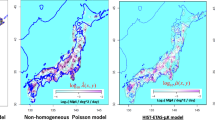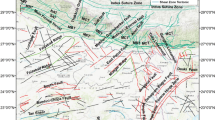Abstract
We construct a single hazard function from multiple predictive parameters independently developed for moderate earthquakes in Kanto, Japan, during a learning period from 1990 to 1999, and applied to a testing period from 2000 to 2005. Here, we consider as predictive parameters the a and b values of the Gutenberg–Richter relation, the ν value (change in b value), and the Every Earthquake a Precursor According to Scale (EEPAS) model rate. To study the correlations among the parameters, we prepare two groups of space–time coordinate sets for assessment, namely the background and conditional groups selected from the learning period. The background group contains ten thousand sets of coordinates randomly selected from the space–time volume of our study. The conditional group contains 33 sets of space–time coordinates corresponding to the epicenters of the target earthquakes (M ≥ 5.0) just before their times of occurrence. Each parameter for the background group is transformed so that its distribution conforms to the standard Normal function. The mean and variance of the conditional distribution is then estimated after applying the same transformation to the conditional group. Using the means and variances of b values, ν values and EEPAS rates and the correlation matrices in the background and conditional distributions, we construct a combined hazard function following the procedure developed for normally distributed parameters. The information gain per event (IGpe) of the new hazard function is 0.26 and 0.3 units larger than that of the EEPAS rate for the learning and testing period, respectively. The R-test confirms the statistical significance of the difference in the IGpe value for the testing period.







Similar content being viewed by others
References
Aki, K., A probabilistic synthesis of precursory phenomena. In Earthquake Prediction, (eds., D. W. Simpson and P. G. Richards) (AGU, 1981) pp. 566–574.
Daley, D. J. and Vere-Jones, D., An introduction to the theory of point processes, vol. 1, Elementary theory and methods, Second edition (Springer, New York 2003).
Dougherty, E. R., Probability and statistics for the engineering, computing and physical sciences (Prentice-Hall, Inc., Englewood Cliffs, 1990).
Evison, F. F. and Rhoades, D. A. (2002), Precursory scale increase and long-term seismogenesis in California and northern Mexico, Ann. Geophys. 454, 479–495.
Evison, F. F. and Rhoades, D. A. (2004), Demarcation and scaling of long-term seismogenesis, Pure Appl. Geophys. 161, 21–45.
Grandori, G., Guagenti, E., and Perotti, F. (1988), Alarm systems based on a pair of short-term earthquake precursors, Bull. Seism. Soc. Am. 78, 1538–1549.
Hamada, K. (1983), A probability model for earthquake prediction, Earthquake Prediction Res. 2, 227–234.
Hamada, K., Ohtake, M., Okada, Y., Matsumura, S., and Sato, H. (1985), A high quality digital network for microearthquake and ground tilt observations in the Kanto-Tokai area, Japan, Earthq. Predict. Res. 3, 447–469.
Imoto, M. (2003), A testable model of earthquake probability based on changes in mean event size, J. Geophys. Res. 108, ESE 7.1-12 No. B2, 2082, doi: 10.1029/2002JB001774.
Imoto, M. (2004), Probability gains expected for renewal process models, Earth Planets Space 56, 563–571.
Imoto, M. (2006a), Earthquake probability based on multidisciplinary observations with correlations, Earth Planets Space 57, 1447–1454.
Imoto, M. (2006b), Statistical models based on the Gutenberg-Richter a and b values for estimating probabilities of moderate earthquakes in Kanto, Japan. In Proceed. The 4th International Workshop on Statistical Seismology, January 9–13, 2006, ISM Report on Research and Education, ISM, Tokyo, Japan, 23, 116–119.
Imoto, M. (2007), Information gain of a model based on multidisciplinary observations with correlations, J. Geophys. Res. 112, B05306, doi: 10.1029/2006JB004662.
Imoto, M. (2008), Performance of a seismicity model based on three parameters for earthquakes (M ≥ 5.0) in Kanto, central Japan, Ann. Geophys. 51, 727–736.
Imoto, M. and Yamamoto, N. (2006), Verification test of the mean event size model for moderate earthquakes in the Kanto region, central Japan, Tectonophys. 417, 131–140.
Jackson, D. D. and Kagan, Y. Y. (1999), Testable earthquake forecasts for 1999. Seismol. Res. Lett. 70, 393–403.
Kagan, Y. Y. and Jackson, D. D. (1995), New seismic gap hypothesis: Five years after. J. Geophy. Res. 100, 3943–3960.
Obara, K., Kasahara, K., Hori, S., and Okada, Y. (2005), A densely distributed high-sensitivity seismograph network in Japan: Hi-net by National Research Institute for Earth Science and Disaster Prevention, Rev. Sci. Instrum. 76, 021301.
Reasenberg, P. and Matthews, M. (1988), Precursory seismic quiescence: A preliminary assessment of the hypothesis, Pure Appl. Geophys. 126, 373–406.
Rhoades, D. A. and Evison, F. F. (1979), Long-range earthquake forecasting based on a single predictor, Geophys. J. R. Astr. Soc. 59, 43–56.
Rhoades, D. A. and Evison, F. F. (2004), Long-range earthquake forecasting with every earthquake a precursor according to scale, Pure Appl. Geophys. 161, 47–72.
Rhoades, D. A. and Evison, F. F. (2006), The EEPAS forecasting model and the probability of moderate-to-large earthquakes in central Japan, Tectonophys. 417, 119–130.
Schorlemmer, D., M. Gerstenberger, M. C., Wiemer, S., Jackson, D. D., and Rhoades, D. A. (2007), Earthquake likelihood model testing, Seismol. Res. Lett. 78, 17–29.
Utsu, T. (1977), Probabilities in earthquake prediction, Zisin II 30, 179–185 (in Japanese).
Utsu, T. (1982), Probabilities in earthquake prediction (the second paper), Bull. Earthq. Res. Inst. 57, 499–524 (in Japanese).
Acknowledgments
The authors thank Y. Y. Kagan and two anonymous reviewers for their discussions and comments on this manuscript. The second author was supported by the Foundation for Research, Science and Technology under contract CO5X0402, and by the GNS Science Capability Fund.
Author information
Authors and Affiliations
Corresponding author
Appendix
Appendix
The proposed model could be tested with N-, L-, and R-statistics (Kagan and Jackson, 1995). In these tests, statistics obtained from the observed data are compared with a distribution of statistics, which could be empirically obtained with a large number of randomly generated sequences. Where the observed statistics are not consistent with statistics computed assuming a given model to be correct, the null hypothesis that the real earthquake sequences conform to the model may be rejected. In the present study, we will perform these three tests analytically, not with random catalogs.
If an observed score is outside a certain range (for example, ±2 standard deviations from the expected value), the model should be rejected at the respective level of significance (5%). However, a higher likelihood score, even if outside the +2 standard deviations, is regarded as a better model in the L-test (Schorlemmer et al., 2007).
The N-test checks the consistency of the observed number with the earthquake productivity of the proposed model. Assuming the study space–time domain is divided into K cells, an earthquake in each cell follows the Poisson process. The Poisson rate in the j-th cell is noted as λ j , the expected number of event, and its variance Var[n j ] = λ j . The total expected number, E[n], is given by
where an earthquake occurrence in one cell is assumed to be independent from that in another cell. The variance of the total number is given by
The L-test determines the consistency of the observed likelihood with that expected from sequences conforming to the model. The log likelihood for the j-th cell is given by
where Y j is 1 when an earthquake occurs and 0 otherwise, and Ln refers to the natural logarithm. It is assumed that λ j is far less than unity and that at most one earthquake occurs in one cell. The expected value of the log-likelihood, E[l j ] is expressed by
The variance is given by
When an earthquake in one cell is independent from that in another cell, the mean E[l] and variance Var[l] of the log-likelihood for the whole domain are given by
and
The R-test examines whether a difference between the likelihoods of two models is significant. The expected value of the likelihood ratio, E[l 12 j ] is expressed by
where superscripts 1 and 2 refer to the first and second models. It is assumed that earthquake sequences conform to the first model. The variance is given by
The mean E[l 12] and variance Var[l 12] of the log-likelihood ratio for the whole domain are given by
and
Rights and permissions
About this article
Cite this article
Imoto, M., Rhoades, D.A. Seismicity Models of Moderate Earthquakes in Kanto, Japan Utilizing Multiple Predictive Parameters. Pure Appl. Geophys. 167, 831–843 (2010). https://doi.org/10.1007/s00024-010-0066-4
Received:
Revised:
Accepted:
Published:
Issue Date:
DOI: https://doi.org/10.1007/s00024-010-0066-4




